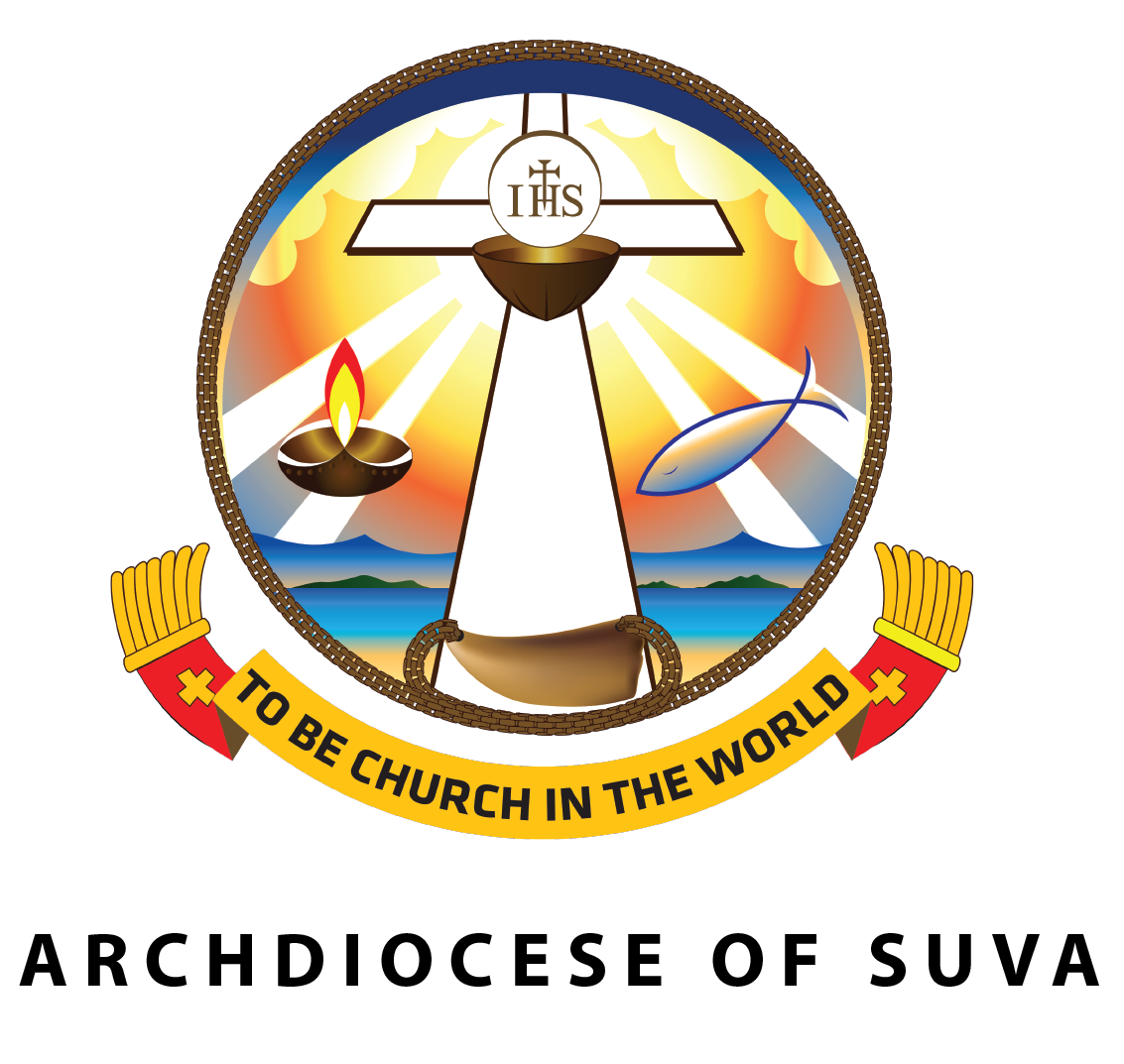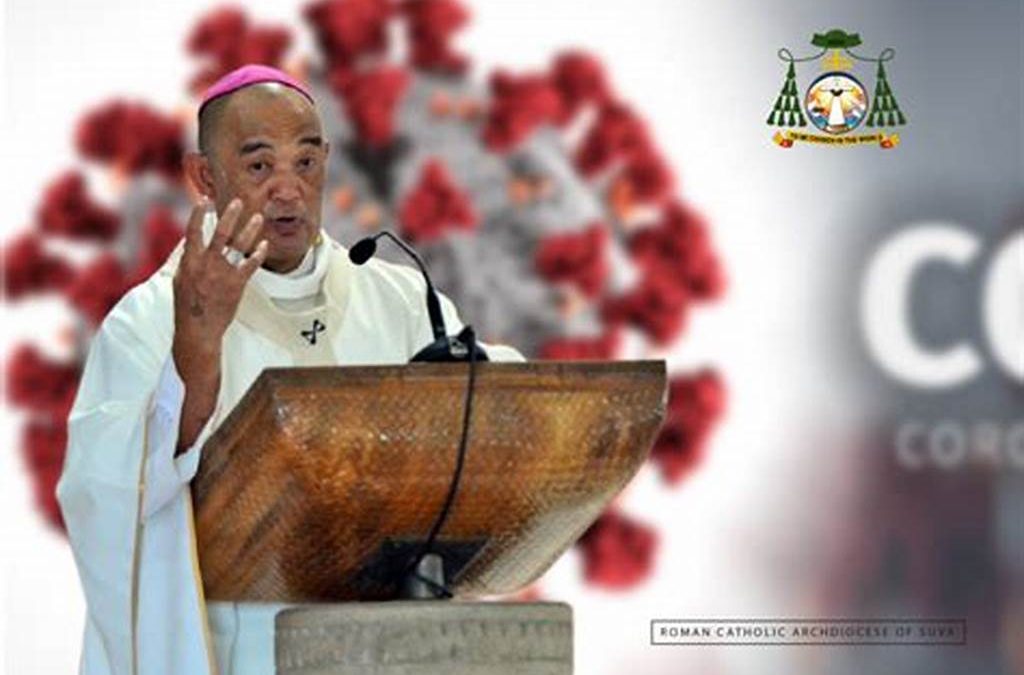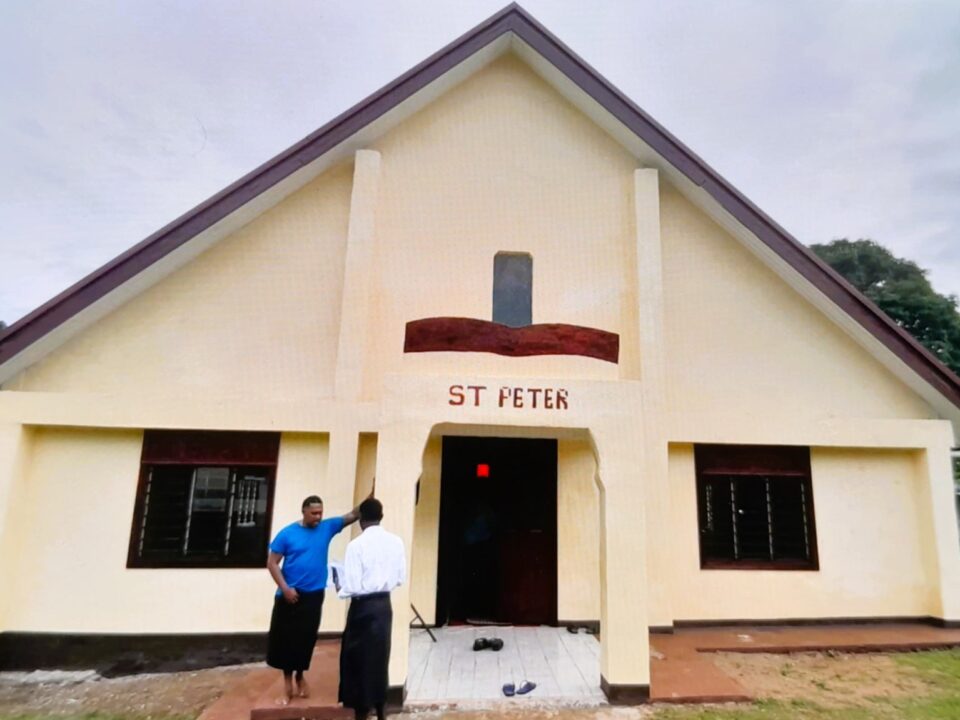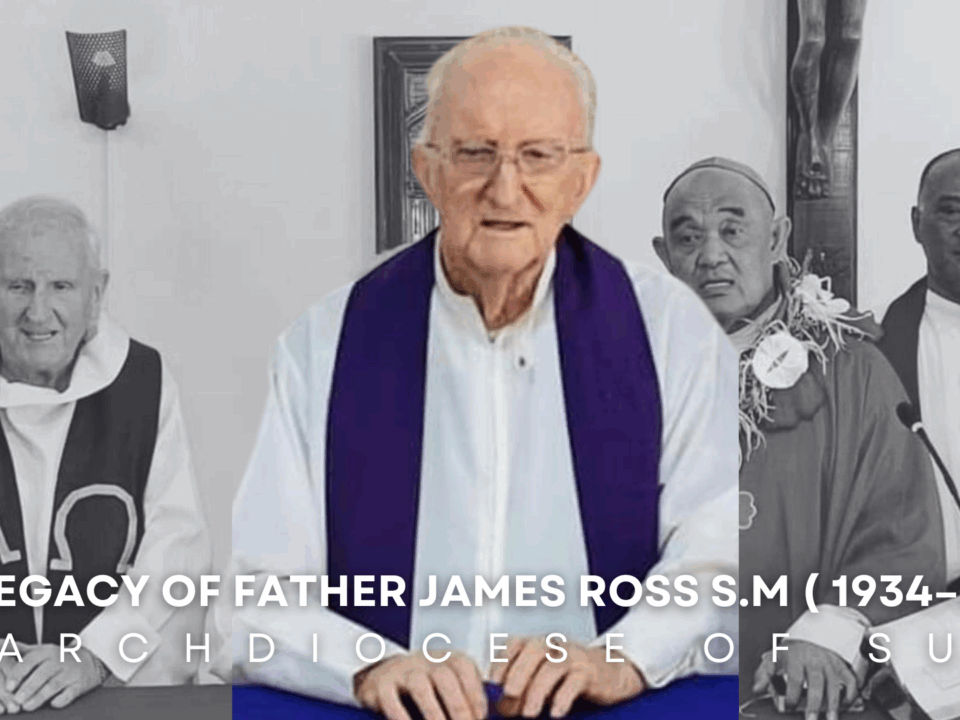Archbishop Peter Loy Chong’s Message on the Return to Public Worship
Returning to Public Worship
Dear Parish Priests and Parishioners,
Greetings and hope you are safe and well.
I have put together below the Fiji Government protocols for Churches and Specific Instructions for Catholic Churches to help us prepare for church opening on 4th October.
These guidelines are being provided to pastors at this time to assist them in their pastoral planning as they develop policies and procedures that will be appropriate for their parish community and worship space. Pastors are encouraged to form a “reopening task force” consisting of 3-4 parishioners to assist in reviewing these guidelines and implementing them as will best fit the needs of their parish.
FIJI GOVERNMENT
PROTOCOL FOR COVID SAFE OPERATION
FOR HOUSES OF WORSHIP
The following principles set the mandatory minimum parameters for safely operating Houses of Worship during the COVID-19 pandemic.
The protocols and measures contained herein are designed to ensure minimal risk when conducting religious activities and may be subject to review (modification, additional or removal).
- All eligible persons must be fully vaccinated1 and present their respective vaccination cards in order to enter the premises. Only in exceptional circumstances where an exemption letter is provided by the Ministry of Health and Medical Services (MHMS), an unvaccinated person can enter. (Vaccination mandate is for 18 years and over. Under 18 children can enter the Church unvaccinated)
- Houses of Worship managers must verify the vaccination status of the eligible persons through the Vax-Check tool or the vaccination card from 4 October, 2021.
- Houses of Worship can operate with a strict 2 – meter physical distancing. For capacity specification, please refer to the Fijian COVID Safe Economic Recovery Framework 2.0. The table below summaries operations and capacity:
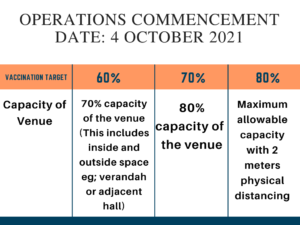
- Houses of Worship trustees must ensure all persons wear appropriate PPE, such as masks and maintain 2-metre physical distance at all times.
- Outdoor seating, where available, must be opened. (This means we can use the outside verandah or adjacent hall. 70% capacity for both inside and outside space.
- Masks can only be removed when receiving Holy Communion.
- Houses of Worship are strongly encouraged to organise multiple sessions to ensure there is no crowding in or outside of the establishment.
- All persons must download the care FIJI mobile application and keep the device Bluetooth turned on. Only in exceptional circumstances where the use of care-FIJI is not possible, Houses of Worship must maintain a register for contact tracing information. This must include but not limited to name, time/date, ID card, residential address and next-of-kin contacts.
- Houses of Worship must register and download a unique digital geo-identification indicator, through the use of a QR Code, to identify the location of their premises. The QR Code will need to be printed and displayed in entry and exit locations of the Houses of Worship and various branches. All devotees/ congregation shall be required to scan the QR Code using their care-FIJI application when visiting the business location, whereby phone number and the time of entry and exit will be recorded.
- Houses of Worship must make available provision for hand washing facilities and/or sanitisers.
- Houses of Worship must maintain safe hygiene protocols and disinfect all high- touch surfaces regularly. Thorough disinfection to be undertaken every day before opening and closing.
- When preparing devotional offerings, Houses of Worships must ensure hygiene practiced. No sharing of glasses, bilos and cutleries amongst themselves.
- Houses of Worship must maximize natural ventilation by opening windows, doors, and vents when conditions allow (if that does not pose a safety risk), or mechanical ventilation using fans and ducts, or a combination of both. Any poorly ventilated spaces must be identified and steps are taken to improve fresh air flow in these areas. The use of portable air cleaners with High-Efficiency Particulate Air (HEPA) filters in spaces with high occupancy or limited ventilation needs to be a strong consideration.
- In buildings with heating, ventilation, and air conditioning (HVAC) systems, ensure that:
i) These systems are operating in accordance with the manufacturer’s instructions and design specifications;
ii) All regularly scheduled inspections and maintenance procedures are conducted;
iii) Maximize the amount of outside air supplied; and
iv) Where feasible, installing air filters with a Minimum Efficiency Reporting Value (MERV) 13 or higher.
15. Music/live choir, singing (including live music with at least 2 metre physical distancing from the nearest person) is allowable. Congregation singing and dancing is strictly not permitted.
16. In the event a positive case is found on the premises, the MHMS has the right to instruct for the premises too close for decontamination. The MHMS protocols for decontamination will apply.
The MHMS in consultation with MCTTT has developed the above protocols to allow Houses of Worship to commence operations under strict COVID Safe protocols.
Houses of Worship must satisfactorily demonstrate the implementation of COVID Safe protocols.
- All eligible persons must be fully vaccinated1 and present their respective vaccination cards in order to enter the premises. Only in exceptional circumstances where an exemption letter is provided by the Ministry of Health and Medical Services (MHMS), an unvaccinated person can enter.
LEGAL IMPLICATIONS
Any person who fails to comply with the mandatory requirements under this Protocol as ordered by the Permanent Secretary for Health and Medical Services commits an offence and is liable on conviction to a fine not exceeding $10,000 or imprisonment for a term not exceeding 5 years or both under the Public Health Act 1935.
Specific Instructions for Catholic Churches in the Archdiocese of Suva
I. General Principles
A. Church Attendance
- Only those fully vaccinated will be allowed to enter inside Church. Unvaccinated people can only enter the church with an approval letter from the Ministry of Health and Medical Services or use outside space of churches.
- Those who are at a higher risk for COVID-19 (i.e., those who are older than 65 or who have underlying health conditions) are urged not to come to church for Mass. Those who cannot attend Mass may be encouraged to spend time daily reading the Scriptures, praying with their families, watching a broadcast or live-streamed Mass, and making an act of spiritual communion. The Eucharistic Ministers can bring Holy Communion to them.
- Those who feel in any way sick (e.g., oral temperature higher than 99.5°F (37.5 C), cough, chills, muscle aches, headache, sore throat, or new loss of taste or smell) or who are worried about attendance should not enter the church.
- In accord with WHO, children six years and above must wear face masks in public, including when they come to church.
- Attendees should sanitise their hands at the entrance of the church via sanitiser stations.
- All present at Mass should sit 2- meters or more away from others. Families may sit together.
- These items should be posted via signage at the entrance of the church. They should also be posted on the parish website or emailed to parishioners.
B. Preparing the Church
- Hand sanitizers should be placed near the entrances to the church. Face masks should be made available to all parishioners who need them, although those who return should be instructed to wear their own mask. Parishes should ensure that they have adequate supplies of hand sanitizer and face masks on hand for those who do not have their own.
- People entering doors may be limited so that they can be monitored and controlled. All points of entry must remain completely accessible.
- Commonly touched surfaces and items in the church should be regularly cleaned and disinfected. Pews/pew tops, door handles, ambo, microphones, cruets, vessels, books, etc. should be cleaned and sanitized after every liturgy.
- Holy water and baptismal fonts should be emptied.
- Members of the congregation must be seated at least 2- meters apart from each other in all directions. Families may be seated together. Ushers should assist in helping those present to observe this rule, and they should be given training to properly carry out this task.
- Parishes may wish to tape or mark pews, indicating seating placement for individuals. One side of the church may be used for families, while the other may be used for individuals whose seats are clearly marked. In implementing this policy, parishes will find that attendance at each individual Mass would be limited to roughly no more than 70% of a church’s occupancy permit.
- In areas where the faithful will stand in line (for example, when waiting to go to Confession or to receive Holy Communion), tape should be placed on the floor to indicate proper spacing between persons.
- A plan for restroom use should be developed. The number of people who enter a restroom at the same time should be limited, and tape should be placed on the floor outside of the restroom to indicate where people should stand in line to wait, maintaining a 2-meter distance from each other. Restrooms should be sanitized after each liturgy and regularly.
C. Churches Open for Private Prayer/Eucharistic Exposition
- A parish staff member or volunteer should be stationed at the front door when the church is open to ensure that no more than the permitted number of people are present inside the church at one time and that everyone is seated according to social distancing guidelines.
- After each visitor leaves, staff/volunteers should sanitize that area of the pew.
- Doorknobs and other high-traffic areas of the church should be frequently sanitized.
D. Music
- Congregational singing is not recommended at this time. This means that the congregation will not sing. Parts of the Mass will be recited. A cantor or a small group of singers may be spaced out very well apart from each other in a choir loft or other designated area away from the other members of the congregation. If singers will be near others, they should wear a mask.
Celebration of Mass
A. Mass Attendance
- Due to the limited number of persons permitted in the church at any one time (approximately 70% of the permitted occupancy), Masses may be scheduled with greater frequency as needs dictate. Attendance may be based on a first-come, first-served policy, or allocated by some other system, such as a rotation based on the first letter of last names, assigning a Mass time per registered family, an online ticketing system like Eventbrite, etc. Whichever system a parish chooses to use to monitor the number of people present, some space designation should be allowed for walk-in attendance.
- When considering the addition of scheduled Masses, pastors should bear in mind the canonical principle that priests should not celebrate Mass more than twice on a weekday or three times on Sundays and holy days of obligation (Can. 905).
- Outdoor Masses are a real possibility. For example, a Mass could be celebrated on the front steps of a church, or in a church parking lot (perhaps on a platform erected for this purpose). In these cases, Communion should be distributed from central locations.
B. Ministers
- To comply with the Fiji Government protocols, priests who are not fully vaccinated will not be allowed to celebrate Mass. Please note that those who do not follow Fiji Government protocols will be fined $10,000 or five-years imprisonment.
- A priest with a respiratory infection of any kind should not celebrate public Masses or administer sacraments. The same holds for other ministers who might serve at a Mass, as well as for sacristans, ushers, etc. Clergy and lay liturgical ministers should be tested for COVID-19 regularly, where this is possible.
- Altar Servers: It is recommended that altar servers not be used at this time.
- Priests, deacons, readers, and sacristans are to wash/sanitize their hands before and after Mass, and before and after the distribution of Communion.
- The priest celebrant and other ministers should not generally wear masks or gloves during the celebration of Mass. Ministers of Holy Communion, however, should wear a mask (but not gloves) during the time of distribution.
- To the greatest extent possible, all ministers (deacons, lectors, sacristans) should maintain a 2-meter distance from the priest and from each other.
C. Ritual Considerations
- The priest may place the Missal on a stand at the chair or even on the altar when he recites the presidential prayers, rather than having a server hold the book.
-
The offertory procession should be omitted.
- The priest washes hands with hand sanitizer as well as water after the preparation of gifts.
- The invitation to the faithful to exchange a sign of peace should be omitted.
- Ciboria with hosts to be consecrated should be placed on a separate corporal away from the main chalice and paten.
D. Distribution of Holy Communion
- When preparing for Mass, sacristans must carefully wash their hands prior to touching the altar breads and pouring the wine; a mask and gloves are encouraged.
- All vessels containing the bread and wine should remain covered until placed on the altar.
- At the start of Mass, or at a suitable point during Mass, the priest should explain that Holy Communion will be distributed in the usual way, but that those who wish to remain in their places may do so, and they can be invited to make an act of spiritual communion. He may add that the faithful should maintain a 2-meter distance from each other as they come forward for Holy Communion.
- The Precious Blood should not be distributed to the faithful.
- The minister should perform hand hygiene (e.g., with hand sanitizer) immediately before and after distributing Holy Communion.
- All ministers of Holy Communion should wear a mask during the time of distribution.
- Holy Communion may not be distributed with gloves, nor may it be received in the hand if a member of the faithful is wearing gloves.
- The faithful should approach the altar and receive Holy Communion in the usual way, observing a 2-meter distance between each communicant. When receiving Holy Communion, communicants should minimize the time when their mask is lowered.
- Given the frequency of direct contact with saliva in the distribution of Holy Communion on the tongue, it is strongly recommended that every consideration should be made by each individual to receive the host reverently in open hands for the protection of all.
- If the minister senses that his/her fingers have contacted the communicant’s hands or mouth, the minister should pause, place the ciborium on a corporal, and use hand sanitizer. A small table may be placed near each communion station for this purpose. (An ablution cup may also be on the table, and the minister may purify fingers in the ablution cup before using hand sanitizer.) The minister may repeat this process as often as necessary during the distribution of Holy Communion. It is not necessary, however, to use hand sanitizer between each communicant unless contact is made.
- Ministers should not place their hands on the heads of children or adults who are not receiving Communion in the form of a “blessing” during the distribution of Communion.
- At the conclusion of the distribution of Holy Communion, the priest (and any other ministers) should return the remaining hosts to the altar or tabernacle, and then perform hand hygiene (e.g., with hand sanitizer).
E. Collection
- Special provision should be made for the collection. Baskets should not be passed from person to person. Long-handled baskets may be acceptable if the ushers can remain a suitable distance from others. Parishes may also wish to set up central boxes or collection points where the faithful can place their contributions. Signage and announcements can encourage the use of We Share. Offertory money should be placed in a tamper-evident bag, logged, and kept in the safe for at least three days before being counted.
Additional Sacramental Considerations
A. Baptism
The minister should wear a mask throughout the celebration of the sacrament.
- To the extent possible, a minimum 2-meters distance should be kept between the celebrant and others during the ceremony. A limited period of proximity during the anointing, the pouring of water, and the explanatory rites is permissible and necessary.
- Water for baptism is to be changed and blessed before each baptism.
B. Confirmation
- The anointing associated with Confirmation may not take place via the use of a cotton ball or other instrument. The anointing must be performed by the celebrant directly with his hand.
C. Anointing of the Sick
- It is recommended during this period to limit the celebration of the Anointing of the Sick to those who are dying and those about to undergo serious surgery. Communal celebrations of the sacrament should not be scheduled at this time.
- The minister should wear a mask and gloves throughout the celebration of the sacrament. As well, he should use hand sanitizer when entering and leaving the room of the sick.
- With the exception of the anointing itself, the minister should maintain at least a 6-foot distance between himself and the recipient of the sacrament at all times.
- The anointing may take place via the use of a cotton ball or other instrument, and only once on the forehead or another suitable area of the body. Cotton balls should not be reused and may be disposed of via incineration or burial.
- Priests must follow all guidelines set by medical institutions, including the use of PPE. In most cases, only hospital chaplains will be able to anoint in these settings due to limited access to PPE and the training needed in order to properly wear it.
D. Reconciliation
- Both the priest and penitent should wear a mask throughout the celebration of the sacrament.
- A 6-foot distance between the priest and the penitent must be maintained when hearing confessions. In many cases, this may necessitate the temporary use of a partition in an open space or classroom, as most confessional “boxes” will not allow for a 2-meters separation between priest and penitent.
- It is advisable to designate an area where the faithful can wait in line while maintaining a 2-meters from others. Floors should be marked to indicate the required distance.
-
